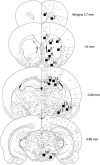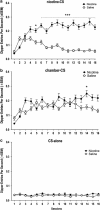Conditioned response evoked by nicotine conditioned stimulus preferentially induces c-Fos expression in medial regions of caudate-putamen
- PMID: 22048468
- PMCID: PMC3280645
- DOI: 10.1038/npp.2011.263
Conditioned response evoked by nicotine conditioned stimulus preferentially induces c-Fos expression in medial regions of caudate-putamen
Abstract
Nicotine has both unconditioned and conditioned stimulus properties. Conditioned stimulus properties of nicotine may contribute to the tenacity of nicotine addiction. The purpose of this experiment was to use neurohistochemical analysis of rapidly developing c-Fos protein to elucidate neurobiological loci involved in the processing of nicotine as an interoceptive conditioned stimulus (CS). Rats were injected (SC) in an intermixed fashion with saline or nicotine (16 sessions of each) and placed in conditioning chambers where they were given one of the three conditions depending on group assignment: (a) nicotine paired 100% of the time with intermittent access to sucrose (nicotine-CS condition), (b) nicotine and saline each paired 50% of the time with sucrose (chamber-CS condition), or (c) no sucrose US control (CS-alone condition). Rats in the nicotine-CS condition acquired the discrimination as evidenced by goal-tracking (ie, increased dipper entries before initial sucrose delivery) only on nicotine sessions. The chamber-CS condition showed goal-tracking on all sessions; no goal-tracking was seen in the CS-alone condition. On the test day, rats in each condition were challenged with saline or nicotine and later assessed for c-Fos immunoreactivity. In concordance with previous reports, nicotine induced c-Fos expression in the majority of areas tested; however, learning-dependent expression was specific to dorsomedial and ventromedial regions of caudate-putamen (dmCPu, vmCPu). Only rats in the nicotine-CS condition, when challenged with nicotine, had higher c-Fos expression in the dmCPu and vmCPu. These results suggest that medial areas of CPu involved in excitatory conditioning with an appetitive nicotine CS.
Figures





Similar articles
-
Double dissociation of the anterior and posterior dorsomedial caudate-putamen in the acquisition and expression of associative learning with the nicotine stimulus.Neuropharmacology. 2017 Jul 15;121:111-119. doi: 10.1016/j.neuropharm.2017.04.026. Epub 2017 Apr 27. Neuropharmacology. 2017. PMID: 28457971 Free PMC article.
-
Interoceptive conditioning with a nicotine stimulus is susceptible to reinforcer devaluation.Behav Neurosci. 2013 Jun;127(3):465-73. doi: 10.1037/a0032691. Behav Neurosci. 2013. PMID: 23731077 Free PMC article.
-
Inactivation of posterior but not anterior dorsomedial caudate-putamen impedes learning with self-administered nicotine stimulus in male rats.Behav Brain Res. 2021 Sep 10;413:113438. doi: 10.1016/j.bbr.2021.113438. Epub 2021 Jul 3. Behav Brain Res. 2021. PMID: 34224762 Free PMC article.
-
Interoceptive Pavlovian conditioning with nicotine as the conditional stimulus varies as a function of the number of conditioning trials and unpaired sucrose deliveries.Behav Pharmacol. 2006 Mar;17(2):161-72. doi: 10.1097/01.fbp.0000197456.63150.cd. Behav Pharmacol. 2006. PMID: 16495724
-
Nicotine as a signal for the presence or absence of sucrose reward: a Pavlovian drug appetitive conditioning preparation in rats.Psychopharmacology (Berl). 2004 Feb;172(1):108-17. doi: 10.1007/s00213-003-1621-9. Epub 2003 Oct 3. Psychopharmacology (Berl). 2004. PMID: 14530902
Cited by
-
Interoception and learning: import to understanding and treating diseases and psychopathologies.ACS Chem Neurosci. 2014 Aug 20;5(8):624-31. doi: 10.1021/cn5001028. Epub 2014 Jul 22. ACS Chem Neurosci. 2014. PMID: 25010473 Free PMC article. Review.
-
Effects of nicotine conditioning history on alcohol and methamphetamine self-administration in rats.Pharmacol Biochem Behav. 2019 Apr;179:1-8. doi: 10.1016/j.pbb.2019.01.005. Epub 2019 Jan 19. Pharmacol Biochem Behav. 2019. PMID: 30664897 Free PMC article.
-
Interoceptive conditioning in rats: effects of using a single training dose or a set of 5 different doses of nicotine.Pharmacol Biochem Behav. 2013 Dec;114-115:82-9. doi: 10.1016/j.pbb.2013.10.025. Epub 2013 Nov 5. Pharmacol Biochem Behav. 2013. PMID: 24201046 Free PMC article.
-
The importance of acquisition learning on nicotine and varenicline drug substitution in a drug-discriminated goal-tracking task.Pharmacol Biochem Behav. 2020 Dec;199:173045. doi: 10.1016/j.pbb.2020.173045. Epub 2020 Oct 12. Pharmacol Biochem Behav. 2020. PMID: 33058788 Free PMC article.
-
Behavioral and neural substrates of habit formation in rats intravenously self-administering nicotine.Neuropsychopharmacology. 2014 Oct;39(11):2584-93. doi: 10.1038/npp.2014.111. Epub 2014 May 14. Neuropsychopharmacology. 2014. PMID: 24823947 Free PMC article.
References
-
- Abramoff MD, Magelhaes PJ, Ram SJ. Image processing with imageJ. Biophoton Int. 2004;11:36–42.
-
- Alessi SM, Roll JM, Reilly MP, Johanson CE.2002Establishment of a diazepam preference in human volunteers following a differential-conditioning history of placebo versus diazepam choice Exp Clin Psychopharmacol 1077–83.discussion 101–103. - PubMed
-
- Azizian A, Monterosso J, O'neill J, London ED. Magnetic resonance imaging studies of cigarette smoking. Handb Exp Pharmacol. 2009;192:113–143. - PubMed
-
- Balfour DJ. The neuronal pathways mediating the behavioral and addictive properties of nicotine. Handb Exp Pharmacol. 2009;192:209–233. - PubMed
-
- Balleine BW, Dickinson A. Goal-directed instrumental action: contingency and incentive learning and their cortical substrates. Neuropharmacology. 1998;37:407–419. - PubMed
Publication types
MeSH terms
Substances
Grants and funding
LinkOut - more resources
Full Text Sources

